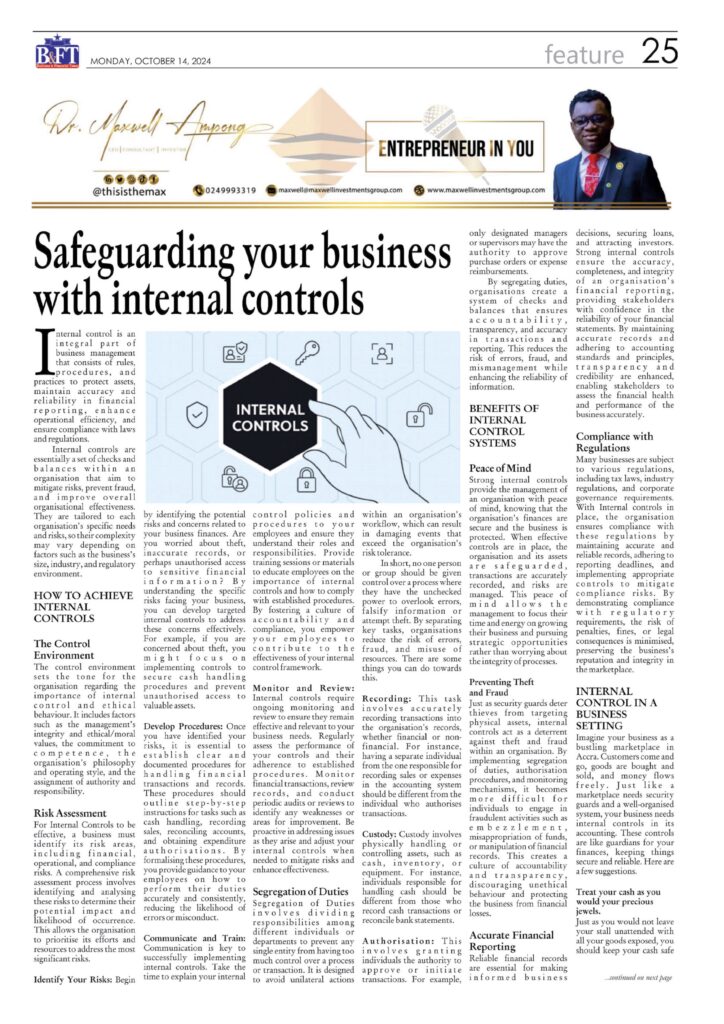
Internal control is an integral part of business management that consists of rules, procedures, and practices to protect assets, maintain accuracy and reliability in financial reporting, enhance operational efficiency, and ensure compliance with laws and regulations.
Internal controls are essentially a set of checks and balances within an organisation that aim to mitigate risks, prevent fraud, and improve overall organisational effectiveness. They are tailored to each organisation’s specific needs and risks, so their complexity may vary depending on factors such as the business’s size, industry, and regulatory environment.
HOW TO ACHIEVE INTERNAL CONTROLS
The Control Environment
The control environment sets the tone for the organisation regarding the importance of internal control and ethical behaviour. It includes factors such as the management’s integrity and ethical/moral values, the commitment to competence, the organisation’s philosophy and operating style, and the assignment of authority and responsibility.
Risk Assessment
For Internal Controls to be effective, a business must identify its risk areas, including financial, operational, and compliance risks. A comprehensive risk assessment process involves identifying and analysing these risks to determine their potential impact and likelihood of occurrence. This allows the organisation to prioritise its efforts and resources to address the most significant risks.
Identify Your Risks: Begin by identifying the potential risks and concerns related to your business finances. Are you worried about theft, inaccurate records, or perhaps unauthorised access to sensitive financial information? By understanding the specific risks facing your business, you can develop targeted internal controls to address these concerns effectively. For example, if you are concerned about theft, you might focus on implementing controls to secure cash handling procedures and prevent unauthorised access to valuable assets.
Develop Procedures: Once you have identified your risks, it is essential to establish clear and documented procedures for handling financial transactions and records. These procedures should outline step-by-step instructions for tasks such as cash handling, recording sales, reconciling accounts, and obtaining expenditure authorisations. By formalising these procedures, you provide guidance to your employees on how to perform their duties accurately and consistently, reducing the likelihood of errors or misconduct.
Communicate and Train: Communication is key to successfully implementing internal controls. Take the time to explain your internal control policies and procedures to your employees and ensure they understand their roles and responsibilities. Provide training sessions or materials to educate employees on the importance of internal controls and how to comply with established procedures. By fostering a culture of accountability and compliance, you empower your employees to contribute to the effectiveness of your internal control framework.
Monitor and Review: Internal controls require ongoing monitoring and review to ensure they remain effective and relevant to your business needs. Regularly assess the performance of your controls and their adherence to established procedures. Monitor financial transactions, review records, and conduct periodic audits or reviews to identify any weaknesses or areas for improvement. Be proactive in addressing issues as they arise and adjust your internal controls when needed to mitigate risks and enhance effectiveness.
Segregation of Duties
Segregation of Duties involves dividing responsibilities among different individuals or departments to prevent any single entity from having too much control over a process or transaction. It is designed to avoid unilateral actions within an organisation’s workflow, which can result in damaging events that exceed the organisation’s risk tolerance.
In short, no one person or group should be given control over a process where they have the unchecked power to overlook errors, falsify information or attempt theft. By separating key tasks, organisations reduce the risk of errors, fraud, and misuse of resources. There are some things you can do towards this.
Recording: This task involves accurately recording transactions into the organisation’s records, whether financial or non-financial. For instance, having a separate individual from the one responsible for recording sales or expenses in the accounting system should be different from the individual who authorises transactions.
Custody: Custody involves physically handling or controlling assets, such as cash, inventory, or equipment. For instance, individuals responsible for handling cash should be different from those who record cash transactions or reconcile bank statements.
Authorisation: This involves granting individuals the authority to approve or initiate transactions. For example, only designated managers or supervisors may have the authority to approve purchase orders or expense reimbursements.
By segregating duties, organisations create a system of checks and balances that ensures accountability, transparency, and accuracy in transactions and reporting. This reduces the risk of errors, fraud, and mismanagement while enhancing the reliability of information.
BENEFITS OF INTERNAL CONTROL SYSTEMS
Peace of Mind
Strong internal controls provide the management of an organisation with peace of mind, knowing that the organisation’s finances are secure and the business is protected. When effective controls are in place, the organisation and its assets are safeguarded, transactions are accurately recorded, and risks are managed. This peace of mind allows the management to focus their time and energy on growing their business and pursuing strategic opportunities rather than worrying about the integrity of processes.
Preventing Theft and Fraud
Just as security guards deter thieves from targeting physical assets, internal controls act as a deterrent against theft and fraud within an organisation. By implementing segregation of duties, authorisation procedures, and monitoring mechanisms, it becomes more difficult for individuals to engage in fraudulent activities such as embezzlement, misappropriation of funds, or manipulation of financial records. This creates a culture of accountability and transparency, discouraging unethical behaviour and protecting the business from financial losses.
Accurate Financial Reporting
Reliable financial records are essential for making informed business decisions, securing loans, and attracting investors. Strong internal controls ensure the accuracy, completeness, and integrity of an organisation’s financial reporting, providing stakeholders with confidence in the reliability of your financial statements. By maintaining accurate records and adhering to accounting standards and principles, transparency and credibility are enhanced, enabling stakeholders to assess the financial health and performance of the business accurately.
Compliance with Regulations
Many businesses are subject to various regulations, including tax laws, industry regulations, and corporate governance requirements. With Internal controls in place, the organisation ensures compliance with these regulations by maintaining accurate and reliable records, adhering to reporting deadlines, and implementing appropriate controls to mitigate compliance risks. By demonstrating compliance with regulatory requirements, the risk of penalties, fines, or legal consequences is minimised, preserving the business’s reputation and integrity in the marketplace.
INTERNAL CONTROL IN A BUSINESS SETTING
Imagine your business as a bustling marketplace in Accra. Customers come and go, goods are bought and sold, and money flows freely. Just like a marketplace needs security guards and a well-organised system, your business needs internal controls in its accounting. These controls are like guardians for your finances, keeping things secure and reliable. Here are a few suggestions.
Treat your cash as you would your precious jewels.
Just as you would not leave your stall unattended with all your goods exposed, you should keep your cash safe too. Internal controls ensure that only authorised individuals handle cash and conduct transactions. For example, you might have separate individuals responsible for recording sales and managing the cash register. This segregation of duties helps prevent unauthorised access to cash and reduces the risk of theft or mishandling.
Records as your Stock Ledger
Just as you maintain a stock ledger to track the inventory in your stall, your business needs accurate records of all income and expenses. These records serve as a financial “stock ledger,” allowing you to keep track of your financial transactions and understand your business’s financial health. Internal controls include procedures for accurately recording transactions and maintaining proper documentation, such as receipts and invoices. By keeping thorough records, you can ensure transparency and accountability in your business operations.
Double-Checking for Accuracy
Imagine having two people count your stock at the end of the day to ensure accuracy. Similarly, internal controls involve checks and balances to verify the accuracy of financial transactions. For instance, one person might record transactions while another reviews the records for errors or inconsistencies. This double-checking process helps identify and correct mistakes before they escalate into significant issues. By implementing such internal controls, you can enhance the reliability and integrity of your financial reporting and decision-making processes.
YOU NEED INTERNAL CONTROLS
Internal control is a cornerstone of effective governance, risk management, and business operations. It encompasses a comprehensive framework of policies, procedures, and practices designed to safeguard assets, ensure accuracy and reliability in financial reporting, promote operational efficiency, and facilitate compliance with laws and regulations.
Throughout this discussion, we have explored key components and benefits of internal control, ranging from segregation of duties and authorisation procedures to reconciliations and access controls. These components work together to mitigate risks, prevent fraud, enhance transparency, and foster organisational accountability.
By implementing strong internal controls, businesses can enjoy several advantages, including peace of mind, protection against theft and fraud, accurate financial reporting, and compliance with regulatory requirements. Internal controls provide stakeholders with confidence in the integrity of financial information, support informed decision-making, and safeguard the reputation and long-term sustainability of the organisation.
However, it is essential to recognise that internal control is not a one-time effort but requires ongoing commitment and vigilance. Businesses must regularly assess the effectiveness of their controls, adapt to changing risks and circumstances, and continuously improve their control environment to meet evolving business needs and regulatory requirements.
Ultimately, internal control is more than just a set of rules and procedures; it is a fundamental aspect of organisational culture and governance. By embedding a culture of integrity, accountability, and transparency, businesses can foster trust among stakeholders, drive operational excellence, and achieve sustainable growth and success in today’s dynamic business environment. Internal control is not just a means to an end; it is a guiding principle that shapes the way organisations conduct their affairs, uphold their values, and fulfil their responsibilities to stakeholders and society at large.
I hope you found this article insightful and enjoyable. Subscribe to the ‘Entrepreneur In You’ newsletter here: https://lnkd.in/d-hgCVPy.
I wish you a highly productive and successful week ahead!
♕ —- ♕ —- ♕ —- ♕ —- ♕
Disclaimer: The views, thoughts, and opinions expressed in this article are solely those of the author, Dr. Maxwell Ampong, and do not necessarily reflect the official policy, position, or beliefs of Maxwell Investments Group or any of its affiliates. Any references to policy or regulation reflect the author’s interpretation and are not intended to represent the formal stance of Maxwell Investments Group. This content is provided for informational purposes only and does not constitute legal, financial, or investment advice. Readers should seek independent advice before making any decisions based on this material. Maxwell Investments Group assumes no responsibility or liability for any errors or omissions in the content or for any actions taken based on the information provided.


